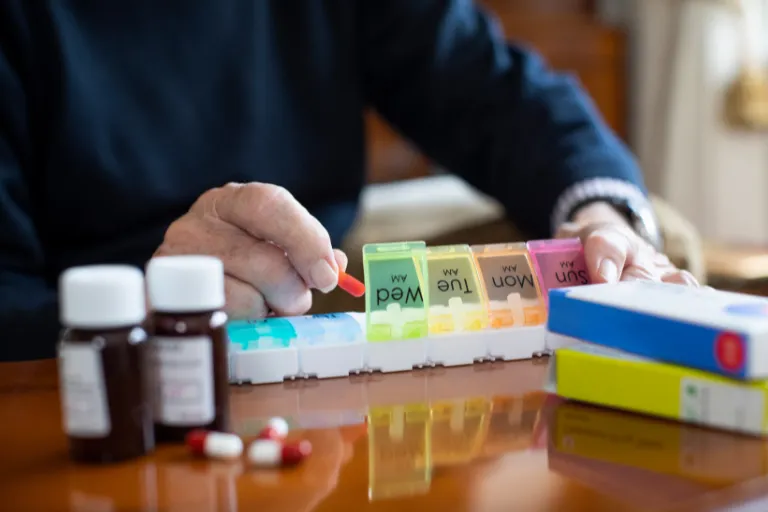Key Points:
- Automatic pill dispensers help reduce medication errors and missed doses.
- They support independence and lessen the burden on caregivers.
- Advanced features like alarms, locking mechanisms, and app-based reminders support safer and more modern medication management.
- They can improve safety, convenience, and overall quality of life for users.
The Hidden Risk of Missed or Mistimed Medications
Every year, nearly 1 million Americans are sent to the emergency room due to medication mistakes—many of them older adults managing complicated pill routines for blood pressure, heart issues, or pain. For families and caregivers, keeping track of multiple prescriptions can feel like a full-time job. What if a simple device could make this process safer, easier, and more reliable?
That’s where automatic pill dispensers come in. Far more than just pillboxes with timers, these devices combine thoughtful design and smart technology to ensure medications are taken correctly, on time, and with less stress.
Why Medication Management Technology Matters
Medication adherence is one of the biggest hidden challenges in modern healthcare. Studies estimate that nearly half of all users don’t take their medications as prescribed, leading to complications ranging from heart problems to avoidable hospitalisations. For those with chronic symptoms or multiple prescriptions, even a small mistake—taking a dose late, skipping a pill, or mixing up medications—can have significant consequences.
Automatic pill dispensers address this problem head-on, bridging the gap between complex medical routines and the reality of daily life. By improving safety and independence, they benefit not just the individual but also caregivers, families, and the wider healthcare system.
10 Key Benefits of Automatic Pill Dispensers
1. Reducing Medication Errors With Automated Accuracy
Automatic dispensers minimise mistakes by releasing only the correct pills at the correct time. Many models include locking lids to prevent double-dosing or access to the wrong medication.
2. Encouraging Consistent Medication Adherence
Alarms, flashing lights, or even voice prompts remind users when it’s time to take a dose. These cues create consistency and reduce the chance of skipped or delayed medications.
3. Promoting Independence for Older Adults
For seniors or those with memory challenges, the ability to self-manage medications boosts confidence and autonomy. Families can step back from constant supervision while still feeling reassured.
4. Easing the Burden on Caregivers and Family Members
Caregivers spend hours each week sorting pills and monitoring schedules. With a dispenser, much of this responsibility is automated, freeing caregivers to focus on quality time rather than logistics.
5. Improving Safety With Locking and Access Controls
Locking features prevent children, pets, or even the user from tampering with medications outside the scheduled time, a critical safeguard in homes with multiple people.
6. Saving Time Through Preloaded Convenience
Instead of opening dozens of pill bottles each week, medications can be preloaded into the dispenser. Some devices can hold weeks’ worth of pills, minimising repetitive tasks and reducing error-prone manual handling.
7. Connecting Care With Smart Technology Integration
Many modern dispensers connect with apps, sending alerts to family members or health professionals if a dose is missed. This integration provides an added safety net and peace of mind.
8. Lowering Costs by Preventing Hospitalisations
Missed or incorrect doses can lead to costly hospital visits. Improved adherence has been linked to fewer emergency visits and better long-term health outcomes.
9. Simplifying Complex Medication Schedules
Users with multiple prescriptions at different times of day benefit from dispensers that can handle complex schedules, ensuring that morning, afternoon, and evening doses are organised seamlessly.
10. Enhancing Quality of Life Through Stress-Free Routines
By simplifying medication routines, users and families experience less stress, fewer arguments over compliance, and greater confidence in managing health—improving overall well-being.
How Automatic Pill Dispensers Fit Into Modern Healthcare
Automatic pill dispensers reflect a broader trend toward technology-assisted care. Just as wearable devices track vital signs, medication-management technology supports one of the most critical aspects of long-term health: adherence. Healthcare providers increasingly recommend these tools as part of care plans, and insurers are beginning to see their value in preventing costly errors.
Still, it’s important to note that while these devices are powerful aids, they don’t replace the role of health professionals. Instead, they serve as a bridge—helping individuals stick to their prescribed therapies while allowing families and professionals to focus on broader aspects of care.
Next Steps for Families and Individuals
If you or a loved one struggles with managing multiple medications, consider whether an automatic pill dispenser might be the right solution. Talk with a health professional about safe setup, explore different device features, and weigh the balance between cost and convenience.
These devices are not one-size-fits-all, but for many households, they represent an important step toward safety, independence, and peace of mind.
Conclusion
Medication adherence is not just a personal responsibility—it’s a public health challenge with far-reaching consequences. Automatic pill dispensers offer a practical, tech-savvy solution that reduces errors, relieves caregiver stress, and enhances quality of life. For individuals managing complex regimens, the right dispenser can be the difference between constant worry and everyday confidence.
This blog post aims to be informational and should not replace professional health advice. Always consult with a health professional for personalised advice.
Subscribe for Free for more insightful health articles tailored to your needs.
Sources
- Gargioni L, Fogli D, Baroni P. A Systematic Review on Pill and Medication Dispensers from a Human-Centered Perspective. Journal of Healthcare Informatics Research. 2024 Feb 22;8(2).
- Olaleye SA, Olubunmi OE, Atsbeha BW, Wodaje MN. Unveiling the complementariness of robotic tablet dispensing machines for elderly care: A bibliometric data analysis. Exploratory Research in Clinical and Social Pharmacy [Internet]. 2024 Nov 26;17:100545. Available from: https://www.sciencedirect.com/science/article/pii/S2667276624001422?via%3Dihub
- Dayananda P, Upadhya AG. Development of Smart Pill Expert System Based on IoT. Journal of The Institution of Engineers (India): Series B. 2024 Feb 2;
- Nasir Z, Asif A, Nawaz M, Ali M. Design of a Smart Medical Box for Automatic Pill Dispensing and Health Monitoring †. Engineering Proceedings [Internet]. 2023;32(1):7. Available from: https://www.mdpi.com/2673-4591/32/1/7




